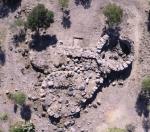Summary (English)
This was the second campaign of excavations in the archaeological area of Candelargiu. The first season took place in 2012 as part of the University of Seville’s “In campis myrteis” project. In 2013, an international project, Proyecto Nuraghe, was set up for the excavation and enhancement of the site and, in 2014, an intensive survey and the first excavations took place.
Situated on flat land a short distance from the sea, the settlement of Candelargiu is very close to a large number of nuragic settlements that are of significant size (Meurras and Sirimagus-Tratalias, Craminalana-S.G.Suergiu, Sirai-Carbonia), attesting the importance of this transit area close to the coast and the rich mineral resources of the Sulcis-Inglesias area. Three large functional spaces were found in the excavation area, corresponding with the nuraghe itself (constituted by three towers linked to a central courtyard), a large hut (probably for public use), and a hut village, of which only a few alignments of stone blocks are visible at present. There was also a well that remains to be investigated. Inside the large hut, diameter 13.5 m, there was a substantial layer of collapse containing a large number of carefully worked “T” shaped blocks of white ignimbrite stone – differing from the dark trachyte used for the construction of all the buildings. Their presence suggests this building was used for cult or civic purposes (probably both), however this needs further investigation.
Fragments of Punic pottery were found both inside and outside the same building, suggesting its reuse in that period.
The same can be said of the area in front of the nuraghe, where a hoard of 26 finely-made gold coins, minted in Carthage (c. 350-270 B.C.) was found. Unfortunately, the context of the hoard’s deposition is not yet known as the season ended before it could be investigated. However, this will be the object of coming campaigns, as will the function of the large hut and main structure of the nuraghe.The first survey of the visible structures (nuraghe and large hut) was undertaken, recording the buildings’ dimensions and acquiring a first point of comparison with similar known structures. It was established that the large hut had a diameter of c. 13.50 m, which makes it one of the largest known among all nuraghic sites, only the so-called meeting hut at Santa Vittoria di Serri (14 m) being larger.
- Manuela Puddu
- Araceli Rodríguez Azogue - Colegio de Doctores y Licenciados en Filosofía y Letras y en Ciencias de Sevilla y Huelva
- Oliva Rodríguez Gutiérrez – Universidad de Sevilla
Director
Team
- Alvaro Fernández Flores
Research Body
- Colegio de Doctores y Licenciados en Filosofía y Letras y en Ciencias de Sevilla y Huelva
Funding Body
- Comune di San Giovanni Suergiu






![Download [PDF]](/excavation/skins/fasti/images/results/download_sml.png)




